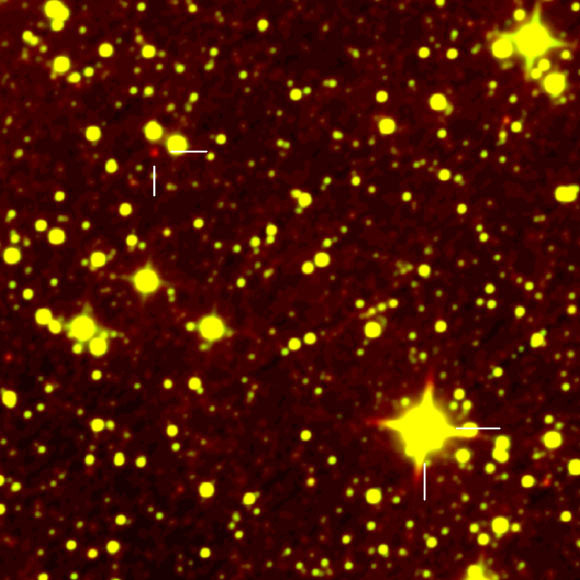Astronomers with the COol Companions ON Ultrawide orbiTS (COCONUTS) program have directly imaged a massive exoplanet orbiting the low-mass red dwarf L 34-26.

This image shows COCONUTS-2b (left) and its host star, COCONUTS-2A (right). Image credit: Zhang et al., doi: 10.3847/2041-8213/ac1123.
L 34-26 is a M3-type dwarf star located 35 light-years away in the constellation of Chamaeleon.
Also known as COCONUTS-2A and TYC 9381-1809-1, the star is about one-third the mass of the Sun and between 150 and 800 million years old.
The newly-imaged planet, named COCONUTS-2b and previously known as WISEPA J075108.79-763449.6, is 6.3 times the mass of Jupiter.
It orbits the parent star once every 1.1 million years at a distance of 6,471 AU (astronomical units).
The astronomers estimate the planet’s temperature to be about 434 K (161 degrees Celsius, or 322 degrees Fahrenheit).
Due to its wide-separation orbit and cool host star, COCONUTS-2b’s skies would look dramatically different to an observer there compared to the skies on Earth.
Nighttime and daytime would look basically the same, with the host star appearing as a bright red star in the dark sky.
“With a massive planet on a super-wide-separation orbit, and with a very cool central star, COCONUTS-2 represents a very different planetary system than our own Solar System,” said Zhoujian Zhang, a graduate student in the Institute for Astronomy at the University of Hawaii at Manoa.
According to the team, COCONUTS-2b is the nearest imaged exoplanet to Earth known to date.
The alien world is also the second widest (after TYC 9486-927-1b at a projected separation of 6,900 AU) and the second coldest (after WD 0806-661b with a temperature of 328 K) imaged exoplanet discovered so far.
COCONUTS-2b can be directly imaged thanks to emitted light produced by residual heat trapped since the planet’s formation.
Still, the energy output of the planet is more than a million times weaker than the Sun’s, so the planet can only be detected using lower-energy infrared light.
“Directly detecting and studying the light from gas-giant planets around other stars is ordinarily very difficult, since the planets we find usually have small-separation orbits and thus are buried in the glare of their host star’s light,” said Dr. Michael Liu, also from the Institute for Astronomy at the University of Hawaii at Manoa.
“With its huge orbital separation, COCONUTS-2b will be a great laboratory for studying the atmosphere and composition of a young gas-giant planet.”
The results were published in the Astrophysical Journal Letters.
_____
Zhoujian Zhang et al. 2021. The Second Discovery from the COCONUTS Program: A Cold Wide-orbit Exoplanet around a Young Field M Dwarf at 10.9 pc. ApJL 916, L11; doi: 10.3847/2041-8213/ac1123







